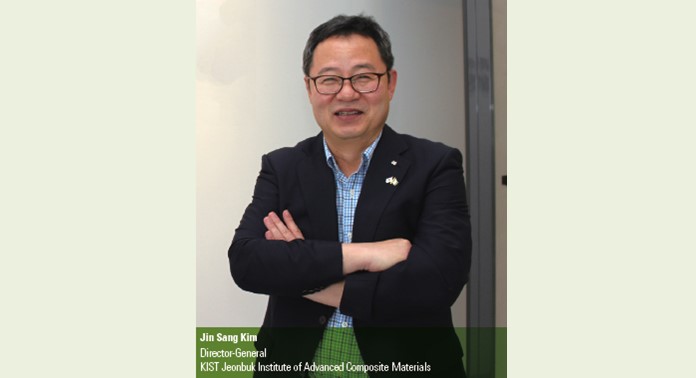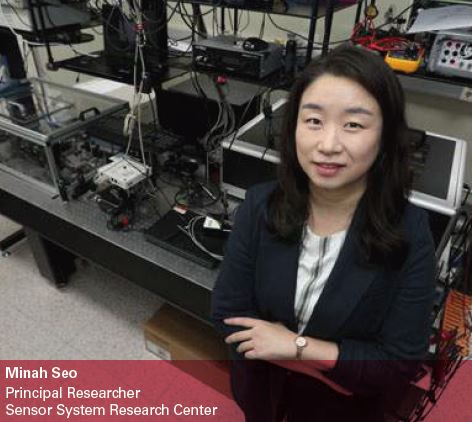
KIST NEWS
-
Latest Research News
A Breakthrough in Green Hydrogen Peroxide Production: KIST Develops Carbon Catalyst Utilizing Airborne Oxygen
A Breakthrough in Green Hydrogen Peroxide Production: KIST Develops Carbon Catalyst Utilizing Airborne Oxygen - Mesopore introduction enables world-class hydrogen peroxide production characteristics even in low oxygen air supply environments - Producing hydrogen peroxide from neutral electrolytes, making it practical and commercially viable Hydrogen peroxide is one of the world's top 100 industrial chemicals with a wide range of applications in the chemical, medical, and semiconductor industries. Currently, hydrogen peroxide is mainly produced through the anthraquinone process, but this process has several problems, including high energy consumption, the use of expensive palladium catalysts, and environmental pollution due to by-products. In recent years, an environmentally friendly method of producing hydrogen peroxide by electrochemical reduction of oxygen using inexpensive carbon catalysts has gained attention. However, this method has been limited by the high cost of injecting high-purity oxygen gas and the practical limitations that the generated hydrogen peroxide is mainly produced in an unstable basic electrolyte environment. To overcome this limitation, a team of researchers led by Dr. Jong Min Kim, Center for Extreme Materials Research Center, Korea Institute of Science and Technology (KIST), Dr. Sang-rok Oh, Center for Computational Science, Dr. Sang Soo Han, Center for Computational Science, Prof. Kwang-hyung Lee, Korea Advanced Institute of Science and Technology (KAIST), and Dr. Joonhee Moon, Korea Basic Science Institute (KBSI), developed a highly efficient mesoporous catalyst that can effectively produce hydrogen peroxide even in air supply environments with low oxygen concentrations and neutral electrolytes by introducing mesopores into the carbon catalyst. The team synthesized boron-doped carbon with mesopores of about 20 nanometers (nm) by reacting the greenhouse gas carbon dioxide (CO₂), the potent reducing agent sodium borohydride (NaBH₄), and meso-sized calcium carbonate (CaCO₃) particles, followed by selective removal of the calcium carbonate particles. Using it as a catalyst for electrochemical hydrogen peroxide production, experiments and calculations have shown that the curved surface characteristics formed by the mesopores provide excellent catalytic activity even in neutral electrolyte environments, where hydrogen peroxide production reactions are difficult. Furthermore, real-time Raman analysis has confirmed that the mesoporous structure facilitates the smooth transfer of oxygen as a reactant, allowing high catalytic activity to be maintained even in air environments with an oxygen concentration of only about 20%. Based on these findings, the team demonstrated that boron-doped mesoporous carbon catalysts, when applied to a hydrogen peroxide mass production reactor, can achieve world-class hydrogen peroxide production efficiencies of more than 80% under near-commercial conditions of neutral electrolyte and air supply and industrial-scale current density (200 mA/cm²). In particular, the team succeeded in producing hydrogen peroxide solutions with a concentration of 3.6%, which exceeds the medical hydrogen peroxide concentration (3%), suggesting the possibility of commercialization. "The mesoporous carbon catalyst technology, which utilizes oxygen from the air we breathe to produce hydrogen peroxide from a neutral electrolyte, is more practical than conventional catalysts and will speed up industrialization," said Dr. Jong Min Kim of KIST. ### KIST was established in 1966 as the first government-funded research institute in Korea. KIST now strives to solve national and social challenges and secure growth engines through leading and innovative research. For more information, please visit KIST’s website at https://eng.kist.re.kr/ This research was supported by the Ministry of Science and ICT (Minister Yoo Sang-im) through the KIST Major Project and Excellent New Research Project (2N74120), Nanomaterial Technology Development Project (2N76070), and Leading Research Center Support Project (NRF-2022R1A5A1033719). The findings are published in the latest issue of the international journal Advanced Materials (IF 27.4, JCR field 1.94%). [Figure 1] [Figure 2] [Figure 3]
2025 - 03 - 17
-
Latest Research News
KIST develops high-performance sensor based on two-dimensional semiconductor
KIST develops high-performance sensor based on two-dimensional semiconductor - Dramatic improvement in sensor performance by overcoming high resistance and Fermi level pinning - Expected to play a key role in the commercialization of next-generation high-efficiency, ultra-compact imaging sensor technology Next-generation imaging technology is rapidly expanding beyond smartphones into intelligent devices, robotics, extended reality (XR) devices, healthcare, CCTV, and various other industries. At the core of these technological advances are highly efficient, ultra-compact image sensors that convert light signals into electrical signals. Image sensors capture and process visual information from objects and environments, enabling precise reconstruction of their shape, size, and spatial position. Currently, commercial image sensors are primarily based on silicon semiconductors. However, research into next-generation image sensors utilizing two-dimensional (2D) semiconductor nanomaterials -potential replacements for silicon- is actively underway. These nanomaterials, composed of atomically thin layers just a few nanometers thick, offer exceptional optical properties and miniaturization potential, making them highly suitable for high-performance image sensors. However, maximizing their performance requires low-resistance electrodes capable of efficiently processing optical signals. Conventional 2D semiconductor-based sensors face challenges in achieving low resistance electrodes, resulting in poor optical signal processing efficiency, which has been a major obstacle to commercialization. Do Kyung Hwang (Post-Silicon Semiconductor Institute, KIST; KU-KIST Graduate School, KIST School) and Dr. Min-Chul Park (Post-Silicon Semiconductor Institute, KIST; Korea University, and Yonsei University), along with their joint research team at the Korea Institute of Science and Technology (KIST, President Sang-Rok Oh), have successfully developed an innovative electrode material called Conductive-Bridge Interlayer Contact (CBIC), enabling the realization of a 2D semiconductor-based image sensor with high optical signal efficiency. By incorporating gold nanoparticles within the electrode, the team significantly reduced its resistance, leading to a substantial improvement in the performance of 2D semiconductor image sensor. Furthermore, they effectively addressed the issue of Fermi level pinning, a common challenge in conventional electrode materials, thereby further enhancing the sensor's optical signal efficiency. In particular, the team applied this technology to successfully implement integral imaging based three-dimensional (3D) imaging and glasses-free display technology, inspired by the compound eye structure of dragonfly. Using integral imaging technology, they achieved the acquisition and reproduction of RGB full-color 3D images, enabling the recording and reconstruction of 3D object shapes. In the future, these high-performance image sensors are expected to be widely used in various advanced industries, including XR devices, artificial intelligence (AI), and autonomous driving systems. "By overcoming the technical limitations caused by electrode issues in existing 2D semiconductor devices, this research is expected to significantly accelerate the industrialization of next-generation imaging system technologies, which offer advantages in light absorption and miniaturization," said Dr. Do Kyung Hwang. He further emphasized the scalability of the research, stating, "The developed electrode material is easy to fabricate and scalable to large areas, making it widely applicable to various semiconductor-based optoelectronic devices." Dr. Min-Chul Park added, "2D semiconductor-based optoelectronic devices that overcome the challenge of Fermi level pinning will have a significant impact across industries that demand ultra-compact, ultra-high-resolution, and high-performance visual sensors in the future." ### KIST was established in 1966 as the first government-funded research institute in Korea. KIST now strives to solve national and social challenges and secure growth engines through leading and innovative research. For more information, please visit KIST’s website at https://eng.kist.re.kr/ This research was supported by the Ministry of Science and ICT (Minister Yoo Sang-im) and the Ministry of Culture, Sports and Tourism (Minister Yoo Yoo-chon) through the KIST Major Project, the National Research Foundation of Korea Individual Research (RS-2023-NR077025), the IITP ITRC Research and Development Project (IITP-2023-RS-00258639), and the Korea Creative Content Agency Culture and Technology Research and Development Project (R2020040080, RS-2020-KC000685). The results of this research were published online in Nature Electronics. [Figure 1] [Figure 2] [Figure 3]
2025 - 03 - 10
-
Latest Research News
Developing zero-waste, sustainable smart polymer materials
Developing zero-waste, sustainable smart polymer materials - Shape memory materials that change color upon damage and self-repair - Chemically recyclable into raw materials, reducing production and disposal costs Plastics, which are polymeric materials composed of long chains of small molecules called monomers, are widely used in everyday life and industry due to their lightweight, good strength and flexibility. However, with approximately 52 million tons of plastic waste generated annually, plastic pollution has become a major environmental concern. To address this issue, research efforts have focused on developing sustainable polymeric materials. Unfortunately, most materials developed so far suffer from complex synthesis processes or difficulties in separating them from other polymers during waste disposal. To overcome these limitations, a research team led by Dr. Tae Ann Kim of the Convergence Research Center for Solutions to Electromagnetic Interference in Future-mobility (SEIF) at Korea Institute of Science and Technology (KIST) has developed a new polymeric material with self-healing capabilities and high recyclability. The team designed a unique pentagonal ring-structured molecule that can not only be freely converted between monomers and polymers but also facilitates dynamic covalent exchange reactions in response to heat, light, and mechanical forces. This molecule enables creating polymeric materials with a wide range of properties, as flexible as a rubber band or as rigid as a glass bottle. The newly developed polymer is easy to manage, as it exhibits fluorescence at damaged sites, enabling real-time damage detection, and self-heals when exposed to heat and light. Upon disposal, this material can selectively depolymerize into its monomers, even when mixed with conventional plastics. The recovered monomers can then be used to regenerate polymers that retain their original properties. These features present an innovative solution for enhancing both sustainability and recyclability of polymeric materials. Beyond its recyclability, this material dynamically change its thermal, mechanical, and optical properties in response to heat, light, and mechanical forces. When used as a protective coating, it demonstrates outstanding performance, with a hardness up to three times and an elastic modulus more than two times higher than conventional epoxy coatings. Additionally, exposure to ultraviolet light strengthens molecular interactions, enabling the material to fix specific shapes. This shape memory capability opens up potential applications in smart clothing, wearable devices, and advanced robotics. With its high mechanical strength, damage resistance, self-healing, damage detection, and selective recyclability, this polymeric material presents a promising solution to reduce economic costs associated with sorting and processing mixed plastic waste. Furthermore, by replacing industrial coatings with this eco-friendly alternative, the maintenance costs of coating can be significantly reduced while mitigating environmental pollution. Dr. Tae Ann Kim, a principal researcher of the Soft Materials Research Group, emphasized, "This research introduces a new approach to designing materials with autonomous functionalities, such as damage detection and self-healing, while overcoming the thermal and mechanical limitations of recyclable plastics derived from pentagonal ring monomers" He further added, "We are striving to pioneer the market for eco-friendly functional coatings that require minimal maintenance and generate no waste." ### KIST was established in 1966 as the first government-funded research institute in Korea. KIST now strives to solve national and social challenges and secure growth engines through leading and innovative research. For more information, please visit KIST’s website at https://eng.kist.re.kr/ This research was supported by the National Research Council of Science and Technology (NST) grant (CRC22033-230) of the Ministry of Science and ICT (Minister Sang-im Yoo) and the Nano & Material Technology Development program (RS-2024-00448445) of the National Research Foundation of Korea. The research was published in the latest issue of Advanced Functional Materials, a leading international journal in materials science (IF 18.5, JCR top 4.329%). [Figure 1] [Figure 2] [Figure 3]
2025 - 03 - 06
-
Latest Research News
Development of 'transparent stretchable substrate' without image distortion could revolutionize next-generation displays
Development of 'transparent stretchable substrate' without image distortion could revolutionize next-generation displays - Overcoming Poisson's ratio enables fully transparent, distortion-free, non-deformable display substrates - Shear-rolling process enables commercialization of large-area, high-transparency stretchable substrates Stretchable display materials, which are gaining traction in the next-generation display market, have the advantage of being able to stretch and bend freely, but the limitations of existing materials have resulted in distorted screens and poor fit. General elastomeric substrates are prone to screen distortion due to the 'Poisson's ratio' phenomenon, in which stretching in one direction causes the screen to shrink in the vertical direction. In particular, electronics that are in close contact with the skin, such as wearable devices, are at risk of wrinkling or pulling on the skin during stretching and shrinking, resulting in poor fit and performance. A research team led by Dr. Jeong Gon Son of the Korea Institute of Science and Technology (KIST) and Professor Yongtaek Hong of Seoul National University has developed a nanostructure-aligned stretchable substrate that dramatically lowers the Poisson's ratio. The research is notable for its ability to reduce the Poisson's ratio while maintaining transparency, solving the problems of screen distortion and light scattering at the same time. The researchers achieved this by combining two key ideas. In the first, they utilized block copolymers, which are polymer blocks linked together to align the internal nanostructures. The block copolymer(SIBS) consists of a stiff 'polystyrene' (PS) and a softer 'polybutylene' (PIB), which can be arranged in one direction to maximize the difference in elasticity between the parallel and perpendicular directions to reduce shrinkage. While conventional elastomers have a Poisson's ratio of 0.4 to 0.5, the researchers have reduced it to a Poisson's ratio of 0.07 or less, which means that there is almost no shrinkage perpendicular to the substrate, even in the stretching direction, and screen distortion is greatly reduced. The second idea was to introduce a shear-rolling process to align the nanostructures evenly across the substrate. It uses speed differences between rollers and stages to apply a uniform shear force at high temperatures. This process allowed the nanostructures to be reliably aligned on thick substrates without compromising transparency. In experiments, the researchers found that there was little longitudinal shrinkage, even when the substrate was stretched by more than 50% in the vertical direction. The researchers applied the developed substrate to a real device and observed changes in the pixel arrangement. The conventional elastomeric substrate, when stretched by 50 percent, showed distortion with jagged spacing between pixels or stuck vertical pixels. The nanostructure-aligned substrate, on the other hand, had an even arrangement of pixels, resulting in an unbroken image and transparency without wrinkles or rough surfaces. The new stretchable substrate is expected to be used as a core material in various fields such as next-generation displays, wearable electronics, and solar cells. In addition, the shear rolling process used in this study can be applied to other block copolymers and polymer films, making it a suitable technology for processing large areas in a simple manner. "This research proposes a new method to develop a distortion-free and completely transparent stretchable substrate by precisely controlling the nanostructure, and the shear-rolling process to implement it can be easily applied to mass production and industrialization," said Dr. Jeong Gon Son of KIST. "We are currently conducting research to realize a real display device with no distortion even when tensile by transferring display light-emitting devices using this substrate." ### KIST was established in 1966 as the first government-funded research institute in Korea. KIST now strives to solve national and social challenges and secure growth engines through leading and innovative research. For more information, please visit KIST’s website at https://eng.kist.re.kr/ This research was supported by the Ministry of Science and ICT (Minister Yoo Sang-im) KIST Major Project, Mid-Career Researcher Support Project (2022R1A2B5B02001597), and STEAM Project (RS-2024-00451691). The research results were published in the latest issue of the international journal Advanced materials (IF 27.4 JCR, top 2.4%). [Figure 1] [Figure 2] [Figure 3]
2025 - 02 - 28
-
Latest Research News
Development of Next-Generation One-Component Epoxy with High-Temperature Stability and Flame Retardancy
Development of Next-Generation One-Component Epoxy with High-Temperature Stability and Flame Retardancy - Groundbreaking improvements achieved with a novel latent curing agent offering exceptional storage stability even at high temperatures - Applicable across industries, including electronics, adhesives/coatings, and electromagnetic shielding, etc. Two-component epoxies, which require mixing resin and curing agent before use, often suffer from issues such as mixing ratio errors, limited working times, and inconsistent curing. Additionally, they must be used immediately after mixing, leading to wasted residue. To address these challenges, one-component epoxies have gained attention. One-component epoxies come pre-mixed, making them easy to use, reducing processing time, and ensuring consistent quality without mixing. In particular, using latent curing agents allows curing to be triggered only under specific conditions (e.g., heat or UV exposure), significantly improving storage stability. However, conventional one-component epoxies are only stable at room temperature (below 25°C), limiting their storage under high-temperature conditions and making them prone to fire hazards. Dr. Jaewoo Kim's research team at the Korea Institute of Science and Technology (KIST, President Sang-Rok Oh), in collaboration with Professor Chongmin Koo's team at Sungkyunkwan University, has developed a groundbreaking solution to overcome these limitations: the "Epoxy/MXene One-Component Solution." This innovative material consists of epoxy resin, polymeric imidazole-based latent curing agent particles, and a two-dimensional nanomaterial called MXene. By introducing a latent curing agent with suppressed reactivity in both physical and chemical ways, the team achieved storage stability for more than 180 days at a high temperature of 60°C-a remarkable improvement compared to conventional products that maintain stability for only about 40 days at 25°C. Furthermore, the MXene nanomaterial significantly enhances flame retardancy while also improving electrical conductivity and thermal stability. The solution also demonstrates outstanding flame-retardant performance. It increases the limiting oxygen index (LOI) by 12% and reduces the peak heat release rate (pHRR) by 85%, achieving the highest V0 flame-retardant rating. This marks a significant improvement over conventional products, which are prone to fire hazards. Mechanically, the material excels with a 46% improvement in tensile strength and a 158% increase in impact strength, ensuring both stability and durability. The research team attributes these performance enhancements to the Diels-Alder reaction of the latent curing agent and the catalytic properties of MXene. This innovative one-component epoxy shows high potential for applications in adhesives, coatings, and electromagnetic shielding materials. It is particularly promising as a next-generation high-performance composite material for the telecommunications, electronic devices, and construction industries. The team plans to further leverage MXene's high electrical conductivity to develop composites with electromagnetic shielding and Joule heating properties. This will enable a broad range of industrial applications and enhance global competitiveness. Dr. Jaewoo Kim of KIST remarked, "This technology represents an innovative one-component epoxy that achieves both high-temperature storage stability and flame retardancy, making it highly applicable in industrial settings. Through our collaboration with Sungkyunkwan University, we aim to strengthen global competitiveness." Professor Chongmin Koo of Sungkyunkwan University emphasized, "MXene's unique two-dimensional nanomaterial properties make it versatile for developing composite materials with flame retardancy and thermal stability, highlighting the significance of this research.“ ### KIST was established in 1966 as the first government-funded research institute in Korea. KIST now strives to solve national and social challenges and secure growth engines through leading and innovative research. For more information, please visit KIST’s website at https://eng.kist.re.kr/ This research was supported by the Ministry of Science and ICT (Minister Sang-Im Yoo) under the Nano and Materials Technology Development Program (2021M3H4A1A03047327), the National Research Council of Science & Technology (NST) under the Convergence Research Program (CRC22031-000), and the Ministry of Trade, Industry and Energy (Minister Deok-Geun Ahn) under the Materials and Components Technology Development Program (20010881) and Nano-Convergence Innovation Development Program (20020855). The research findings have been published in the latest issue of the international journal Advanced Materials (IF 27.4, JCR field ranking 1.9%). [Figure 1] [Figure 2] [Figure 3]
2025 - 01 - 24
-
Latest Research News
Overcoming Nicotine Withdrawal: Clues Found in Neural Mechanisms of the Brain
Overcoming Nicotine Withdrawal: Clues Found in Neural Mechanisms of the Brain - Identification of the role of striatal cholinergic interneurons in nicotine withdrawal symptoms - Discovery of the potential use of FDA-approved Parkinson's drug, Procyclidine, for nicotine withdrawal treatment According to the World Health Organization (WHO), over 22% of the global population smokes, with more than 9 million smoking-related deaths reported annually. Effective treatments to alleviate nicotine withdrawal symptoms caused by smoking cessation are essential for successful smoking cessation. Currently, approved treatments for nicotine withdrawal include Bupropion and Varenicline, but there is a pressing need for new therapeutic options to improve smoking cessation success rates. The research team led by Dr. Heh-In Im at the Center for Brain Disorders of the Korea Institute of Science and Technology (KIST) has identified a novel brain region and neural mechanism involved in regulating nicotine withdrawal symptoms. Building on this discovery, the team found that an existing Parkinson’s disease drug can effectively alleviate nicotine withdrawal symptoms, thus increasing its potential for therapeutic use. When smoking is stopped, specific areas of the brain become hyperactive, causing physical withdrawal symptoms such as tremors and reduced activity. These symptoms significantly disrupt daily life and are major factors leading smokers to relapse. Therefore, understanding the internal processes triggered by nicotine withdrawal is crucial for achieving smoking cessation. The research team pinpointed the role of striatal cholinergic interneurons in nicotine withdrawal symptoms. Through experiments on mice, they selectively inhibited sodium channel expression in the striatal cholinergic interneurons to reduce neural activity. This intervention significantly alleviated tremors caused by nicotine withdrawal. Using advanced multi-electrode array technology, the team confirmed that suppressing cholinergic interneurons completely blocked abnormal neural activity changes. Additionally, microdialysis experiments showed that suppressing cholinergic interneurons restored dopamine levels in the striatum, which had decreased by over 20% during nicotine withdrawal, to normal levels. Based on these findings, the team explored the potential use of Procyclidine, an FDA-approved drug for Parkinson’s disease, for nicotine withdrawal treatment. Procyclidine mimics the inhibition effect on the neural activity of cholinergic interneurons, making it a promising candidate for alleviating physical symptoms of nicotine withdrawal. Notably, administering a single low dose of Procyclidine to mice prior to inducing nicotine withdrawal reduced tremors—a primary physical withdrawal symptom—by over 50%. This study demonstrates the potential of repurposing a safe and established drug for nicotine withdrawal treatment, significantly shortening the clinical trial process. This approach could improve access to smoking cessation therapies and effectively reduce health issues caused by smoking. Dr. Im stated, “This study presents new possibilities for smoking cessation treatment by mitigating the disruptions caused by withdrawal symptoms. It provides an additional treatment option alongside Bupropion and Varenicline. Moving forward, we aim to deepen our understanding of addiction mechanisms, including nicotine, and develop effective therapies.” ### KIST was established in 1966 as the first government-funded research institute in Korea. KIST now strives to solve national and social challenges and secure growth engines through leading and innovative research. For more information, please visit KIST’s website at https://eng.kist.re.kr/ This research was supported by the Ministry of Science and ICT (Minister Sang Im Yoo) through KIST's major project and the Mid-Career Researcher Support Project (2020R1A2C2004610), and a Food and Drug Safety Research Project (RS-2024-00332024). The findings were published in the international journal *Advanced Science* (IF 14.3, JCR ranking 6.5%). [Figure 1] [Figure 2] [Figure 3]
2025 - 01 - 08
-
Latest Research News
Microplastics floating in water, caught by floating drones
Microplastics floating in water, caught by floating drones - Hydrophilic tooth technology develops microplastic recovery technology using floating drones - Expected to be expanded to aquaculture farms, domestic water treatment, etc In recent years, microplastics have garnered significant attention due to their detection in tap and bottled water, as well as in rivers, lakes, and oceans. Conventional filtering technologies for water treatment have difficulty effectively filtering out microplastics of various sizes and shapes and are prone to clogging. Additionally, recovering small particles requires extremely fine filter meshes, which increases pressure and drastically reduces filter efficiency. Furthermore, they are not effective in open spaces such as lakes, rivers, or oceans, where microplastic pollution is increasing. Dr. Seong Jin Kim and Myoung-Woon Moon of the Center for Extreme Materials Research at the Korea Institute of Science and Technology (KIST) have developed a new level of microplastic removal technology, offering a promising solution to this growing problem. They have developed a floating drone equipped with hydrophilic tooth structures that leverage surface tension to skim microplastics. The core of the team's approach is the hydrophilic ratchet structure. This design forms a water bridge that forms between the teeth due to its affinity for water, which maximizes the surface tension of the water to adhere the microplastics to the teeth. This approach enables the removal of microplastics ranging in size from 1 micrometer (μm) to 4 millimeters, addressing the challenges traditional filtering technologies face with size and shape variability. It also ensures reliable operation without the risk of clogging. The technology has achieved over 80% recovery efficiency for various types of microplastics, including expanded polystyrene, polypropylene, and polyethylene. In particular, the hydrophilic ratchet structure of the floating drone can be used to remove microplastics in real-time in large bodies of water such as oceans, lakes, and rivers. The drone can move autonomously and purify water quality like a household robot vacuum cleaner, showing its versatility beyond the limitations of existing fixed systems "This technology can be applied not only to floating drones, but also to stationary systems such as water treatment filters in aquaculture farms," said Dr. Moon. "It can also be expanded into a home water treatment filter device that individuals can use in their daily lives." ### KIST was established in 1966 as the first government-funded research institute in Korea. KIST now strives to solve national and social challenges and secure growth engines through leading and innovative research. For more information, please visit KIST’s website at https://eng.kist.re.kr/ This research was supported by the Ministry of Science and ICT (Minister Yoo Sang-im) under the KIST Institutional Program and the Korea International Maritime Police Service Project (KIMST-20210584). The results of this research were published in the latest issue of the international journal "Advanced science" (IF 14.3, JCR field 8.2%). [Figure 1] [Figure 2] [Figure 3]
2024 - 12 - 16
-
Latest Research News
Developing wastewater treatment units that treat right where it's generated
Developing wastewater treatment units that treat right where it's generated - Continuous flow rapidly breaks down and mineralizes organic matter in water, ready for immediate discharge - Unit produces its own hydrogen peroxide in large quantities and uses it as an oxidant right on site Conventional wastewater treatment involves the centralized collection of wastewater from sources through pipes to large-scale treatment plants, where it is treated in bulk. However, this is not feasible in small, decentralized areas such as rural areas. Simple treatment units installed at small non-point sources of pollution mainly focus on disinfection and turbidity improvement, and do not properly decompose the recalcitrant organic matter in wastewater. In addition, even if industrial wastewater is treated in-house, the treatment efficiency is low, and highly toxic wastewater often needs to be re-transported to a final treatment plant. Dr. Sang Hoon Kim, Extreme Materials Research Center, Dr. Jong Min Kim, Materials Architecturing Research Center, and Dr. Sang Soo Han, Computation Science Research Center, all from the Korea Institute of Science and Technology (KIST), have developed an electrochemical device that can treat sewage and wastewater from pollution sites to the level of discharge. In particular, it can rapidly and completely decompose recalcitrant materials into inorganic substances and discharge them on its own. While previous research methods mainly focused on the development of electrode materials for the generation of hydrogen peroxide, a powerful electrochemical oxidant, this study introduced a flow cell method to generate a large amount of hydrogen peroxide while circulating wastewater in the device, mixing it well, and oxidizing and decomposing recalcitrant organic matter in situ to rapidly mineralize it. This is a structure that can completely degrade organic matter much more efficiently than conventional treatment tanks. Conventional oxidation treatments for harmful organics in water often require multiple steps before the organics are completely degraded, and the intermediate products are often still toxic. When organic matter in water is completely decomposed and mineralized, it becomes non-toxic and can be discharged, and the indicator of this is called total organic carbon (TOC). Since last year, after 48 years, the Ministry of Environment has added total organic carbon to the wastewater discharge standards to impose stricter wastewater treatment standards. The small-scale electrochemical device developed by the KIST research team is a technology that can effectively treat sewage and wastewater directly on-site, which is difficult to treat centrally, and can effectively reduce the total organic carbon in a short time. In fact, the researchers demonstrated excellent complete decomposition performance, reducing the total organic carbon of 50pm bisphenol A by 93% in 2 hours. "The developed device is composed of a continuous and repetitive flow method, which shows higher complete decomposition efficiency than the existing method, and a patent is pending for the device and processing method. We are also planning to transfer the technology to commercialize it." ### KIST was established in 1966 as the first government-funded research institute in Korea. KIST now strives to solve national and social challenges and secure growth engines through leading and innovative research. For more information, please visit KIST’s website at https://eng.kist.re.kr/ This research was supported by the Ministry of Science and ICT (Minister Yoo Sang-im) under the KIST Institutional Program, Usu Shinjin (RS-2023-00209940), Nanomaterial Technology Development Project (NRF-2022M3H4A7046278), and the Ministry of Environment (Minister Han Hwa-jin) Environmental Technology Development Project (2021002800005). The research was published in the latest issue of the international journal Applied Catalysis B:Environment and Energy (IF: 20.2 JCR, top 0.6%) [Figure 1] [Figure 2] [Figure 3]
2024 - 12 - 09
-
Latest Research News
Developing highly efficient recovery materials for precious 'rare earth metals' and improving resource circulation...
Developing highly efficient recovery materials for precious 'rare earth metals' and improving resource circulation for digital infrastructure - Recovery of rare earth metals from waste permanent magnets to reduce foreign dependence - Development of fibrous adsorption materials with improved performance, productivity, economy, and applicability, and improved industrial stability Korea imports 95% of its core minerals such as lithium, nickel, and rare earths. Rare earths, in particular, are characterized by chemical, electrical, magnetic, and luminescent properties that can be achieved by adding only a small amount, and their use has recently increased significantly as core materials in the eco-friendly automobile and renewable energy industries. China, a major producer of rare metals, is controlling the supply through its strategy of weaponizing resources, putting great pressure on the domestic industry. Dr. Jae-Woo Choi and his team at the Center for Water Cycle Research at the Korea Institute of Science and Technology (KIST) recently announced the development of a fiber-based recovery material that can recover rare earth metals such as neodymium (Nd) and dysprosium (Dy) with high efficiency. The new material is expected to contribute to solving rare earth supply and industrial stability issues by recovering and recycling rare earth metals (neodymium-iron-boron (Nd-Fe-B)) that are mainly used in third-generation permanent magnets, which are essential components in the electric vehicle, hybrid vehicle drive motors, wind power, robotics, and aerospace industries. KIST researchers have developed a nanostructured composite fiber material composed of metal-organic structures and polymer acryl fiber composite fibers to efficiently recover rare earth metals. The adsorptive material is based on acrylic fibers, which are already widely used in Korea, and is economical and productive. The researchers expect that the developed material will be of great industrial use as it easily adsorbs rare earths from waste liquids while facilitating their recovery. The developed fiber material showed adsorption capacities of 468.60 mg/g for neodymium and 435.13 mg/g for dysprosium, the highest in the world. This is significantly higher than conventional adsorption materials and can be applied to simple reactors, which can significantly improve the energy efficiency of the recovery process. The team expects the material to be able to effectively recover rare earths not only from waste permanent magnets, but also from a variety of industrial wastewaters containing rare earth metals, such as mine drainage. In particular, its easy surface modification makes it applicable to a wide range of industrial wastewaters, and it is expected to become a technological alternative for securing rare metal resources. "The high-efficiency rare earth metal recovery material developed in this study is a technology that can replace existing granular adsorption materials, showing excellent results in terms of performance, productivity, economy, and applicability, which will revitalize the digital infrastructure waste mineral extraction ecosystem, and has great potential for industrial application through resource recycling," said Dr. Jae-Woo Choi of KIST. "In the future, the technology can be expanded to selectively recover various useful resources, including rare earths, from industrial wastewater, contributing to carbon neutrality and rare earth-related upstream and downstream industries," said Dr. Youngkyun Jung. ### KIST was established in 1966 as the first government-funded research institute in Korea. KIST now strives to solve national and social challenges and secure growth engines through leading and innovative research. For more information, please visit KIST’s website at https://eng.kist.re.kr/ This research was supported by the Ministry of Science and ICT (Minister Yoo Sang-im) under the KIST Major Project, Leading Materials Innovation Project (2020M3H4A3106366) and Sejong Science Fellowship (RS-2023-00209565). The research results were published in the latest issue of the international journal Advanced Fiber Materials. [Figure 1] [Figure 2] [Figure 3]
2024 - 12 - 06
-
Latest Research News
Developing new polymeric nanomaterials to detect harmful substances in extreme environments
Developing new polymeric nanomaterials to detect harmful substances in extreme environments - KIST-Yale team develops new nanomaterials based on mixed ion-electron conductors - Eco-friendly, durable sensors for high temperature and humidity environments are expected to have a wide range of applications Polymers have gained prominence in applications such as wearable electronics due to their flexibility and lightweight, but their low electrical conductivity has been a major drawback. While various research efforts have been made to improve conductivity, there are still technical limitations, such as the need to use harmful solvents and performance degradation in extreme environments. The Korea Institute of Science and Technology (KIST) announced that it has developed a method for synthesizing polymers based on ion-electron mixed conductors through collaborative research with Dr. Jang Ji-soo of KIST's Center for Electronic Materials Research and Professor Mingjiang Zhong of Yale University in the United States. The research overcomes the limitations of existing polymeric conductors and is attracting attention as an innovative technology that can contribute to the development of next-generation high-performance chemical sensors. To solve this problem, the researchers introduced ionic pendant groups into the polymer structure to synthesize conjugated polymers that can easily dissolve in eco-friendly solvents rather than toxic solvents. In particular, the polymers exhibit high gas sensing performance in eco-friendly processes and can maintain stable performance in high temperature and humidity environments. This technological advance opens up the possibility of applications in wearable devices, portable electronics, and other electronic devices that can operate reliably in extreme environments. At the center of this research is the development of an ionization-based conjugated polymer that is soluble in an environmentally friendly solvent (2-methylanisole). While conventional conductive polymers typically require toxic solvents to dissolve, the new polymer significantly improves electrical conductivity through the binding of ionic species and electronic charge carriers. By introducing anions (TFSI-) and cations (IM+) into the polymer to increase the density and mobility of the charge carriers, the team maximized conductivity and stability. The n-type based conductive polymer developed by the researchers, N-PBTBDTT, showed a very high sensitivity in detecting harmful gases such as nitrogen dioxide (NO2). The sensitivity for NO2 detection was as high as 189%, and it showed high detection ability even at a very low concentration of 2 ppb. This performance exceeds that of conventional sensor technologies, and the polymer was also highly durable in environments with high humidity of 80% and high temperatures of up to 200°C. This enables stable gas detection in a variety of extreme environments, and is expected to be widely applied to wearable devices and industrial sensors. "The sensors developed in this research go beyond simple chemical sensors and can bring about revolutionary changes in various applications," said Dr. Jang Ji-soo of KIST. "In particular, it can be used as a life-saving material for those who work in extreme environments, such as firefighters who need to detect harmful gases at fire scenes and soldiers who are exposed to chemical weapons in wartime," said Prof. Junwoo Lee and Dr. Juncheol Shin, first authors. ### KIST was established in 1966 as the first government-funded research institute in Korea. KIST now strives to solve national and social challenges and secure growth engines through leading and innovative research. For more information, please visit KIST’s website at https://eng.kist.re.kr/ This research was supported by the Ministry of Science and ICT (Minister Yoo Sang-im) as Institutional Program of KIST, and the results were published* in Advanced Functional Materials (IF: 18.5, within the top 5% of the JCR field), an authoritative journal in the field of energy materials. [Figure 1] [Figure 2] [Figure 3]
2024 - 11 - 25
-
Press Release
KIST and India’s Christ University Sign MOU to Strengthen Research and Talent Development Collaboration (Apr. 22, 2025)
KIST and India’s Christ University Sign MOU to Strengthen Research and Talent Development Collaboration KIST (President: Sang-Rok Oh) has signed a Memorandum of Understanding (MOU) with Christ University in India (Vice Chancellor: Jose C. C.) to foster deeper research collaboration and joint talent development. The signing ceremony took place on April 10 at Christ University’s campus in Bengaluru, India. The MOU outlines a comprehensive framework for cooperation between the two institutions, including: - Exchanges of research personnel and students - Joint development of educational and training programs - Sharing of academic publications and information - Collaboration in mutually beneficial research areas Founded in 1969 in Karnataka’s capital, Bengaluru, Christ University is one of India’s premier private universities. It has maintained a strong research partnership with KIST’s Indo-Korea Science and Technology Center since its establishment in Bengaluru in 2010. This collaboration has been particularly active in areas such as big data and software development. KIST President Sang-Rok Oh remarked, “This agreement with Christ University, a leader in IT education and research, marks a significant step forward in collaboration with both the Indo-Korea Science and Technology Center and the KIST headquarters in Seoul, and will also help to address the growing shortage of science and technology talents by attracting highly skilled Indian students to Korea.” Christ University Vice Chancellor Jose C. C. added, “We are honored to build upon our long-standing partnership with the Indo-Korea Science and Technology Center and formalize our collaboration with KIST. We hope that this agreement will enable us to jointly address cutting-edge scientific challenges and generate impactful outcomes for the global science and technology community in both of our countries.” Both institutions emphasized that this MOU represented their continued commitment to contributing to meaningful scientific progress and global talent development for both countries through initiatives such as research partnerships and personnel and student exchanges.
2025 - 04 - 23
-
Press Release
KIST’s Dr. Choi Ji-Hyun Selected for Prestigious HFSP Award (Apr. 2, 2025)
KIST’s Dr. Choi Ji-Hyun Selected for Prestigious HFSP Award KIST (President: Sang-Rok Oh) is proud to announce that Dr. Ji Hyun Choi, Principal Researcher at KIST’s Center for Brain Disorders, has been selected for the 2025 Human Frontier Science Program (HFSP). In a fiercely competitive process involving 807 candidate teams with 2,208 researchers, Dr. Choi’s team emerged as one of only 30 teams (comprising 92 researchers) to receive this distinguished grant. Under the Research Grants Track, Dr. Choi and her collaborators will receive funding of USD 400,000 annually over the next three years, totaling USD 1.2 million. Dr. Choi plans to form an international collaborative research team together with Dr. Ahmed El Hady from Max Planck Institute, Germany and Professor Robert Froemke from New York University, USA to study “the neural and metabolic mechanisms behind group foraging behavior.” This groundbreaking research aims to explore how groups of rats collaborate to develop survival strategies in real-world environments by investigating the intricate connections between the brain and neural circuits, hormones and metabolic states, and social interactions. A key aspect of the team’s work is the innovative use of KIST’s proprietary Clustered Wireless EEG Measurement System (CBRAIN) to integrate and record behavioral, physiological, and neural activity. Additionally, the project will combine New York University’s 24-hour behavioral monitoring system with a predictive mathematical model developed at the Max Planck Institute to quantitatively decipher the brain–physiology–social mechanisms that underpin cooperative behavior for survival. The Human Frontier Science Program is a renowned international funding initiative that supports pioneering, interdisciplinary collaborative research aimed at unraveling complex biological mechanisms. Since its inception in 1989, HFSP has supported over 8,500 researchers from 73 countries, with 31 awardees later receiving Nobel Prizes – earning it the nickname “the Nobel Prize Fund.” For the 2025 cycle, a total of five Korean researchers, including Dr. Choi, Professors Woo-Jung Shin and Young-Gyu Yoon from KAIST, Dr. Nuri Choi from the University of Konstanz in Germany, and Dr. Yu-Ri Hong from the Max Planck Institute of Molecular Cell Biology and Genetics, have been selected as awardees. About the honor, KIST President Sang-Rok Oh stated, “KIST congratulates Dr. Choi for her selection as a recipient of the prestigious HFSP Award in recognition of her outstanding research innovation. KIST will continue to actively support researchers in undertaking bold, challenging projects that drive scientific achievement.”
2025 - 04 - 23
-
Press Release
KIST Expands Global R&D Collaboration to Support Corporate Internationalization (Mar. 27, 2025)
KIST Expands Global R&D Collaboration to Support Corporate Internationalization KIST (President: Sang-Rok Oh) is taking new strides in supporting corporate global technology commercialization. On March 27, KIST hosted the “Global Expansion Support Briefing for Partner Companies” at its headquarters in Seongbuk-gu, Seoul, inviting key industry partners to explore collaborative opportunities. The event saw participation from over 100 partner companies, with KIST presenting its four international research hubs and their specialized joint R&D support programs designed to facilitate global expansion. These four hubs are: - Vietnam-Korea Institute of Science and Technology (VKIST): Supports Korean companies entering the Vietnamese market through joint R&D that reflects the needs of both the Korean and Vietnamese industries, while accelerating technology commercialization for local enterprises - KIST Europe: Operates an acceleration program in partnership with German innovation clusters, fostering collaboration between Korean and European companies - Indo-Korea S&T Center: Focuses on localized R&D in computational science, new materials, and AI to enhance technological integration in the Indian market - Korea-Boston Bridge (K-BB) Center: Works closely with MIT, Harvard, and other leading institutions in Boston to support global commercialization and market entry in the biotech sector Following the program presentations, one-on-one consultation sessions were held, allowing partner companies to engage directly with KIST experts to tailor R&D strategies to their specific needs. Through its global R&D infrastructure, KIST aims to accelerate corporate overseas expansion and commercialization, particularly in the deep tech sector. Moving forward, the institute plans to enhance open innovation initiatives, including joint technology commercialization programs, to ensure sustained industry support. KIST President Oh remarked, “KIST is committed to going beyond one-time technology transfers, focusing instead on continuous technological development to strengthen the global competitiveness of deep tech companies. This briefing marks the beginning of our expanded efforts to empower partner companies with the resources they need for successful global market entry.” With these initiatives, KIST continues to solidify its role as a key enabler of global innovation, helping businesses thrive in an increasingly competitive international landscape.
2025 - 04 - 01
-
Press Release
KIST and Samsung E&A Launch High-Temperature Electrolysis Demonstration Project (Mar. 27, 2025)
KIST and Samsung E&A Launch High-Temperature Electrolysis Demonstration Project On March 25, 2025, KIST (President: Sang-Rok Oh) announced that a kickoff ceremony with Samsung E&A (President Namkoong Hong) was held on March 24 at KIST’s headquarters in Seongbuk-gu, Seoul, marking the official launch of a 160kW Solid Oxide Electrolysis Cell (SOEC) Hot Box demonstration project. The event took place at the KIST Clean Hydrogen Collaboration Hub Center and was attended by key representatives, including President Oh of KIST and President Namkoong Hong of Samsung E&A. This project marks South Korea’s first high-temperature electrolysis demonstration initiative following the enactment of the Hydrogen Act, signifying a major step toward industrial-scale hydrogen production. KIST and Samsung E&A laid the groundwork for this collaboration through a joint Memorandum of Understanding (MOU) signed in February 2024. In July of the same year, they established a Joint Electrolysis Research Lab and have since worked together to develop and evaluate large-scale SOEC stacks and demonstration facilities. Notably, in December 2024, the project received final regulatory sandbox approval, paving the way for full-scale technology validation and demonstration. The demonstration facility has been strategically designed as a small-scale pilot system to conduct preliminary assessments for future large-scale electrolysis deployment. Given the unique characteristics of SOEC technology, the project will focus on evaluating system safety, operational efficiency, and performance optimization at high temperatures. Leveraging KIST’s expertise in high-temperature electrolysis research and Samsung E&A’s extensive experience in large-scale energy projects, both organizations are committed to ensuring the successful execution of this demonstration. Speaking at the ceremony, KIST President Oh emphasized, “This initiative marks the beginning of a long-term partnership between KIST and Samsung E&A. Together, we aim to drive key technological innovations that will shape the future hydrogen economy and accelerate the transition to a sustainable energy paradigm.” Through this collaboration, KIST and Samsung E&A reaffirm their commitment to advancing next-generation hydrogen technologies and establishing South Korea as a leader in the global hydrogen economy.
2025 - 04 - 01
-
Press Release
KIST Celebrates 59th Anniversary with Commemorative Ceremony (Feb. 14, 2025)
KIST Celebrates 59th Anniversary with Commemorative Ceremony On February 10, 2025, KIST (President: Sang Rok Oh) held a commemorative ceremony to celebrate its 59th anniversary at Johnson Auditorium in its Seoul headquarters. The event featured an awards ceremony recognizing outstanding research achievements, the premiere of KIST’s new promotional video, and a performance by the Seongbuk-gu Junior Choir, adding a dynamic and celebratory touch to the occasion. This year’s ceremony was themed "Evergreen Pine," symbolizing how the resilience and pioneering spirit of KIST researchers is much like the enduring strength of a pine tree. At the heart of the ceremony was the presentation of the KIST Grand Award, the highest honor given among the monthly KIST Scientist Award recipients. This year’s recipients, Dr. Suk Woo Nam and Dr. So Young Lee from KIST’s Clean Hydrogen Institute, were recognized for their groundbreaking work in developing a next-generation fuel cell technology with unparalleled electrochemical performance and durability. The Songgok Science and Technology Award, established in honor of KIST’s founding President, Dr. Hyeong-Sup Choi, was awarded to Professor Yong Young Noh of POSTECH for his contributions to the development of p-type oxide semiconductors. Additionally, the KIST Global Partnership Award, which acknowledges individuals who have significantly advanced international cooperation in science and technology with KIST, was presented to H.E. István Szerdahelyi, Ambassador of Hungary to South Korea. Following the official ceremony, a luncheon gathering was held to foster camaraderie and engagement among KIST employees and alumni. In the main lobby, a “Vision for the 60th Anniversary” message board was installed, encouraging attendees to share their aspirations for KIST’s future, creating a meaningful moment of reflection and inspiration. In his commemorative address, KIST President Sang Rok Oh remarked, “Since its inception, KIST has laid the foundation for South Korea’s scientific and technological advancement, continually driving innovation and shaping new frontiers. Now, as we face an era of unprecedented change and challenges, science and technology remain our most vital tools for overcoming crises. KIST must stand at the forefront, leading South Korea’s scientific community towards bold transformation and a future of boundless possibilities.” Since its establishment in 1966, KIST has played a pivotal role in national development through innovative research. Recently, the institute marked a historic milestone with its largest-ever technology transfer agreement, demonstrating the real-world economic impact of its R&D achievements. This success underscores KIST’s technical excellence and robust industry-academia-research collaborations, reaffirming its critical role in driving South Korea’s industrial and economic growth. As KIST prepares to celebrate its 60th anniversary next year, it remains committed to solidifying its position as a global leader in scientific research and accelerating advancements for a sustainable future.
2025 - 02 - 25
-
Press Release
KIST, Sinsin Pharm Sign Exosome-Hydrogel Technology Transfer Agreement for Inflammatory Disease Treatment (Feb. 7, 2025)
KIST and Sinsin Pharm Sign Exosome-Hydrogel Platform Technology Transfer Agreement for Inflammatory Disease Treatment On January 24, 2025, KIST (President: Sang Rok Oh) signed a technology transfer agreement with Sinsin Pharm (CEO: ByoungKi Lee) for the development of an exosome-hydrogel platform for the treatment of inflammatory diseases. The signing ceremony was held at KIST’s headquarters in Seongbuk-gu, Seoul. The signing marks a significant step in collaborative efforts to advance targeted therapies for diabetic foot ulcers and psoriasis. Diabetes is a prevalent health concern in South Korea, affecting approximately one in three adults over the age of 65. Among diabetic patients, 15–25% experience diabetic foot ulcers (DFU), a severe condition that can lead to limb amputation in advanced cases. While current treatments such as antibiotics, blood flow enhancement, and debridement surgery exist, they are often associated with high recurrence rates and slow healing. Similarly, psoriasis is a chronic inflammatory skin disease caused by immune system dysfunction. Despite the availability of steroid creams, phototherapy, and immunosuppressants, current treatments focus on symptom management rather than a permanent cure. Prolonged treatment poses significant burdens on patients, highlighting the urgent need for more effective and patient-friendly therapies. To revolutionize inflammatory disease treatment, a research team at KIST has proposed a sprayable hydrogel therapy incorporating milk-derived exosomes. These milk exosomes are highly stable, biocompatible, and cost-effective for mass production. With natural anti-inflammatory and regenerative properties, they can be further enhanced by encapsulating active pharmaceutical ingredients (APIs) such as bilirubin to maximize therapeutic efficacy. By integrating exosomes into functional hydrogels, the KIST research team aims to introduce a spray-type hydrogel that can be directly applied to wound areas, transforming the treatment paradigm for inflammatory diseases. To ensure the swift commercialization of this breakthrough technology, KIST has committed to supporting Sinsin Pharm through its BP Plus program for the next two years. This initiative will facilitate joint laboratory operations between the two organizations, enhancing technology readiness levels (TRL) and market preparation. Dr. Young Mee Jung, Principal Researcher at KIST’s Biomaterials Research Center and principal investigator for the study, commented, “This novel sprayable hydrogel, combined with a high-efficacy exosome complex, enables rapid and convenient application to large wound areas to treat inflammatory diseases. We believe this technology has the potential to overcome the limitations of existing treatments.” KIST President Sang Rok Oh emphasized the importance of strategic partnerships, stating, “Sinsin Pharm is a leading company specializing in topical pharmaceuticals. We are thrilled that KIST’s cutting-edge research is transitioning from the laboratory to real-world applications through this collaboration. KIST will continue to provide institutional support to ensure this technology can be commercialized.” Sinsin Pharm CEO ByoungKi Lee added, “This technology transfer will enable us to offer an innovative, patient-friendly treatment for diabetic foot ulcers and psoriasis, addressing the high unmet medical needs in these conditions. Through close collaboration with KIST, we will show our commitment to delivering high-quality pharmaceutical solutions that improve patients’ quality of life.” Founded in 1959, Sinsin Pharm is a leading provider of external-use pharmaceuticals, specializing in patches, aerosols, and liquid formulations. As South Korea moves toward a super-aging society, the company is actively developing convenient and accessible medications to enhance the quality of life for elderly patients. Through this strategic partnership, KIST and Sinsin Pharm aim to set new standards in inflammatory disease treatment, reinforcing their commitment to scientific innovation and patient-centered healthcare solutions.
2025 - 02 - 25
-
Press Release
KIST Showcases Future Innovation Technologies at CES 2025 (Feb. 7, 2025)
KIST Showcases Future Innovation Technologies at CES 2025 KIST (President: Sang Rok Oh) announced that it would be participating in CES 2025, the world’s largest IT trade show, held in Las Vegas, USA, from January 7 to 10. This marks KIST’s fifth time taking part in the expo, following appearances in 2020, 2022, 2023, and 2024. At Eureka Park, a space dedicated to showcasing groundbreaking innovations, KIST unveiled seven cutting-edge technologies in the AI, semiconductor, quantum technology, and healthcare sectors, described in more detail below. The Post-Silicon Semiconductor Institute’s Center for Quantum Technology presented a pioneering AI-based technology that converts 2D single X-ray images into 3D visualizations while enhancing image clarity even in challenging conditions such as inclement weather. Dr. Min-Chul Park, the Principal Researcher at KIST responsible for the development of this technology, received the CES 2025 Innovation Award in recognition of his technological prowess. The AI & Robotics Institute showcased an AI-powered real-time traffic monitoring system, developed by Dr. Ig Jae Kim. The system analyzes vehicle tracking, counting, and speed estimation using only CCTV footage to help manage the traffic environment. In collaboration with TOPES, the technology is aimed to be integrated with smart traffic enforcement and intersection simulation for optimized urban mobility. The aim is to implement a system optimized for actual traffic situations by combining this technology with the forward/rear traffic control technology and smart intersection simulation technology of TOPES. In the future, this technology is likely to be developed into unmanned traffic control and intelligent traffic systems. Principal Researcher Gi Pyo Nam from the Center for Artificial Intelligence Research has developed a biometric analysis system that evaluates a person’s internal and external physiological signals through facial recognition. With high accuracy and rapid processing speed, this technology has applications in law enforcement, healthcare, and smart home services. Principal Researcher Heeseung Choi, also from the Center for Artificial Intelligence Research, introduced an AI-enabled kiosk that automatically verifies the identity of laboratory personnel and detects whether they are wearing appropriate personal protective equipment (PPE) to determine whether or not they may access the laboratory. This system enhances lab safety and is expected to become a key technology in research and industrial sites. The Biomedical Research Division unveiled a Nano-Column CMUT-based wearable ultrasound patch, developed by Dr. Byung Chul Lee. Offering three times the performance of conventional ultrasound devices, this silicon-based patch is more environmentally friendly and can be used as a disposable product due to its low manufacturing cost. The patch is expected to expand into home telemedicine and various industrial applications. The Center for Advanced Biomolecular Recognition introduced a urine-based bladder cancer detection kit developed by Dr. Youngdo Jeong. This technology enables non-invasive, rapid diagnosis of bladder cancer using only a smartphone and a urine sample, eliminating the need for preprocessing or specialized medical equipment. It is a simple system that can diagnose bladder cancer at an early stage with high sensitivity and can be used frequently while reducing pain and infection risk for patients. And the Advanced Materials and Systems Research Division’s Electronic Materials Research Center presented an ultrasonic wireless charging system developed by Dr. Hyun-Cheol Song. This technology can wirelessly charge implanted medical devices, such as pacemakers, reducing the need for surgical battery replacements. It also holds potential for use in various industrial fields where long-distance wireless charging is required, such as underwater drones and sub-marine sensor networks. Commenting on the event, KIST President Sang Rok Oh stated, "KIST is proud to present its advanced technologies and products from innovative startups supported by KIST at CES 2025. We are committed to fostering global partnerships to accelerate the transfer and commercialization of KIST technologies, both in Korea and internationally."
2025 - 02 - 24
-
Press Release
KIST Future Foundation Hosts 'Future Foundation Scholar Award' and Scholarship Ceremony (Feb. 6, 2025)
KIST Future Foundation Hosts 'Future Foundation Scholar Award' and Scholarship Ceremony On December 20, 2024, the KIST Future Foundation held an award and scholarship presentation ceremony at the Korea Institute of Science and Technology (KIST). The purpose of the event was to recognize outstanding researchers and students, award the Future Foundation Scholar Award, and provide scholarships to student researchers and early-career scientists. During the ceremony, Dr. Yong-Jik Kim, Chairman of the KIST Future Foundation, and Dr. Sang Rok Oh, President of KIST, presented the Future Foundation Scholar Award to Dr. Kwan Young Lee, Principal Researcher at KIST and Head of the Clean Hydrogen Storage and Utilization Strategy Research Center. As a newly appointed scholar at KIST, Dr. Lee received a research incentive grant of KRW 50 million along with a certificate of recognition. The grant is part of an initiative supported by POSCO and other industry leaders which aims to foster nationally significant R&D and enhance Korea’s research capabilities by supporting top-tier researchers in key scientific fields. Although only one newly appointed scholar was recognized this year, the Foundation plans to expand the award to two recipients annually based on the potential for interdisciplinary synergy, urgency of social problem-solving, and overall research impact. The award is expected to serve as a major incentive for leading scientists who contribute significantly to Korea’s scientific and industrial development. Following the Future Foundation Scholar Award, the event featured the presentation of scholarships, made possible through generous contributions from various foundations and corporate sponsors. The Guwon Scholarship Foundation contributed KRW 60 million, enabling the selection of 10 KIST postdoctoral researchers with outstanding research achievements. Each recipient was awarded a certificate and a KRW 6 million scholarship to support their continued research endeavors. Additionally, the KT&G Scholarship Foundation sponsored scholarships for KIST student researchers, with KIST Future Foundation Chairman Yong-Jik Kim, KT&G Scholarship Foundation Chairman Seung-Taek Kim, and KIST President Sang Rok Oh in attendance. A total of 33 student researchers, including both Korean and international students, were selected to receive a certificate and a KRW 3 million scholarship. This initiative was funded by a KRW 100 million grant from the KT&G Scholarship Foundation, aimed at fostering global scientific talent. Notably, the international scholars who received a scholarship represented six countries: Belarus, Mongolia, Indonesia, Vietnam, Bangladesh, and China. Recipients were chosen from among master’s, doctorate, and integrated MS-PhD programs based on their academic excellence and research performance. Established in March 2022, the KIST Future Foundation is the first public-interest foundation founded within Korea’s government-funded research institutes. The Foundation actively supports the development of highly skilled scientists, addresses pressing social challenges through academic initiatives, and provides scholarships to inspire and empower future generations. Since its inception, the Foundation has received ongoing support from KIST employees, alumni, and industry partners, strengthening its commitment to advancing national scientific and technological capabilities.
2025 - 02 - 24
-
Press Release
KIST and Huons Bio Pharma Sign Technology Transfer Agreement for Peptide Therapy Targeting Dry AMD (Feb. 6, 2025)
KIST and Huons Bio Pharma Sign Technology Transfer Agreement for Peptide Therapy Targeting Dry AMD On December 17, 2024, the Korea Institute of Science and Technology (KIST), led by President Sang Rok Oh, signed a technology transfer agreement with Huons BioPharma (CEO: Yeong-mok Kim) to develop a peptide-based therapy for dry age-related macular degeneration (AMD). The signing ceremony took place at KIST’s headquarters in Seongbuk-gu, Seoul. Under the agreement, the two organizations will engage in a 14-month joint research collaboration to accelerate the commercialization of the peptide therapy, with a focus on improving treatments for elderly patients. The Natural Product Drug Development Division, launched in September 2024 as one of KIST’s mission-driven research institutes, is leveraging more than 20 years of expertise in drug discovery accumulated at KIST’s Gangneung Natural Products Research Center to advance global natural product-based pharmaceuticals. The division aims to develop novel treatments for cancer and age-related refractory diseases, including AMD, by utilizing cutting-edge bio-convergence technologies, and drive forward new drug development through the establishment of Target Product Profiles (TPPs) for each material and external collaborations with pharmaceutical companies and contract research organizations (CROs). The peptide therapy was identified as a key candidate for dry AMD through close collaboration with leading research institutions in Gangwon Province. Moving forward, KIST and Huons Bio Pharma will work together to advance the therapy to global clinical trials. Dr. Moon-Hyung Seo, the principal investigator at KIST, stated, “The KIST Natural Product Drug Development Division, established this past September, is focused on mission-driven research to develop global therapeutics for age-related diseases, particularly cancer and ophthalmic disorders. Through technology transfers and our BP Plus initiative, we plan to operate joint research labs with industry partners, facilitating the rapid commercialization of our innovations.” KIST President Sang Rok Oh emphasized the significance of the agreement, stating, “This collaboration between KIST and Huons Bio Pharma is a prime example of our BP Plus initiative, which actively supports our technology transfer partners with the commercialization process. It is also a meaningful milestone, being the first success story from KIST’s mission-driven research institutes, which were launched this year. We hope this partnership will help bring KIST’s cutting-edge technology to the market, ultimately improving public health.” Yeong-mok Kim, CEO of Huons Bio Pharma, expressed strong commitment to the project, saying, “As the global population ages, securing a robust pipeline of peptide-based therapeutics will be crucial for gaining a competitive edge in the age-related disease market. We will closely collaborate with KIST to advance this innovative dry AMD therapy through global clinical trials and secure regulatory approvals.” Huons Bio Pharma, a subsidiary of Huons Group, specializes in biopharmaceuticals, including botulinum toxin products. The company was established in 2021 through a corporate spinoff from Huons Global’s biotechnology division.
2025 - 02 - 24
-
Press Release
KIST Holds 3rd Term Upright Citizen Auditors Appointment Ceremony and Regular Meeting (Nov. 26, 2024)
KIST Holds 3rd Term Upright Citizen Auditors Appointment Ceremony and Regular Meeting On November 26, 2024, the Korea Institute of Science and Technology (KIST), led by President Sang Rok Oh, announced the launch of the 3rd term of its Upright Citizen Auditors during an appointment ceremony held that day at KIST's Seoul headquarters. The ceremony, attended by the KIST President and key officials, was followed by a regular meeting where discussions were held under the theme “Strategies for Promoting Anti-Corruption and Integrity Policies.” The newly appointed 3rd Term Upright Citizen Auditors include Professor Jae Hoon Lee (Lawyer, School of Law, Sungshin Women’s University), Certified Public Accountant Gu-Ho Choi (Daeyoung Accounting Corporation), and Labor Attorney Chae-Nui Park (Hansoo Labor Law Firm). Each of them will serve for a two-year term. The Upright Citizen Auditor system is an external anti-corruption initiative introduced and run by KIST since 2017, designed to provide consultation on KIST's major projects and areas prone to corruption, and makes suggestions and recommendations for system improvements. KIST President Sang Rok Oh remarked, “Over the past eight years, the Upright Citizen Auditors have played a crucial role in helping us improve outdated systems and practices through their advice and suggestions. With the launch of the 3rd Term of this auditor system, we anticipate continued active participation and meaningful contributions to strengthening KIST’s integrity.” He also emphasized KIST’s ongoing dedication to enhancing organizational transparency. KIST has consistently demonstrated its commitment to ethical management, having obtained ISO 37001 (Anti-Bribery Management Systems) certification in 2021. Looking ahead, KIST plans to be the first government-funded research institute to introduce and acquire ISO 37301 (Compliance Management Systems) certification by 2025. These efforts reflect KIST’s goal to achieve global standards not only in research excellence but also in ethical governance, reinforcing its reputation as a trusted institution among the government and the public.
2024 - 12 - 17
Research Interviews
-
Hope for perosns with diabetes with "blood glucose monitoring sensor without blood sampling
-
[Current Issues] Ministry of Science and Technology Protects the Blue Sky
-
[GRaND-KIST] From commercialization to future studies...
-
A scientist’s Father Assist in Clinical Research ... New Indicator in Early Diagnosis of Dementia
-
World Day for Laboratory Animals...At the KIST Research Animal Resources Center
-
Was it a quantum computer that fought aganist Thanos?
-
“Ready by 2024” KIST Unveils New Artificial Cloud Chamber Dr. Seongsoo Yeom Oversees Research into Artificial Rainfall and the Construction of a Cloud Chamber
-
From Professionalism and Connectivity to Creative Support
-
“We Will Create an Immersive Environment for Researchers to Achieve Regional Development.”
-
Unraveling the Principle of Convergence between Science and Art


.jpg)
.jpg)

![[KISToday] Infinite Scalability: Prioneering a New Fuel Cell Technology](/app/board/attach/image/15116_1743489981000.do)
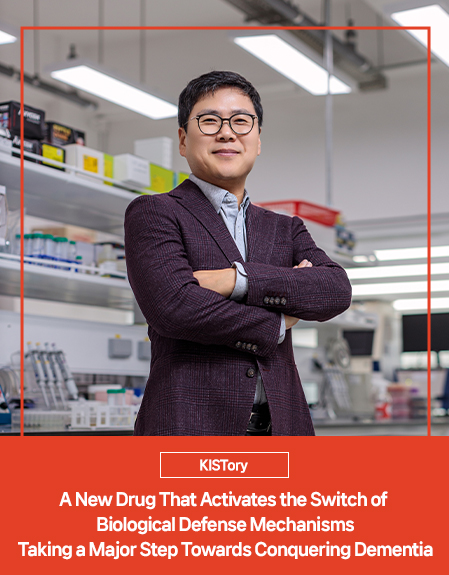
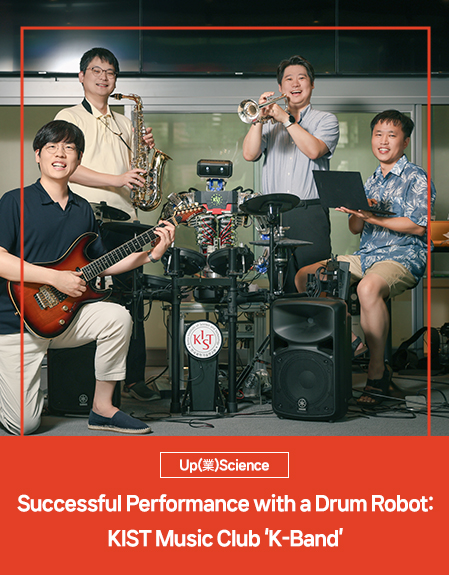
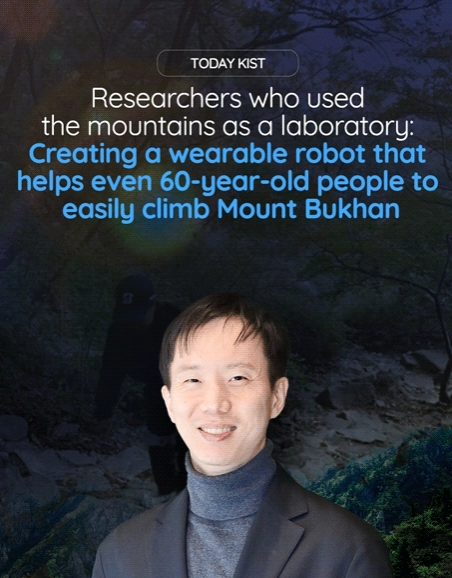
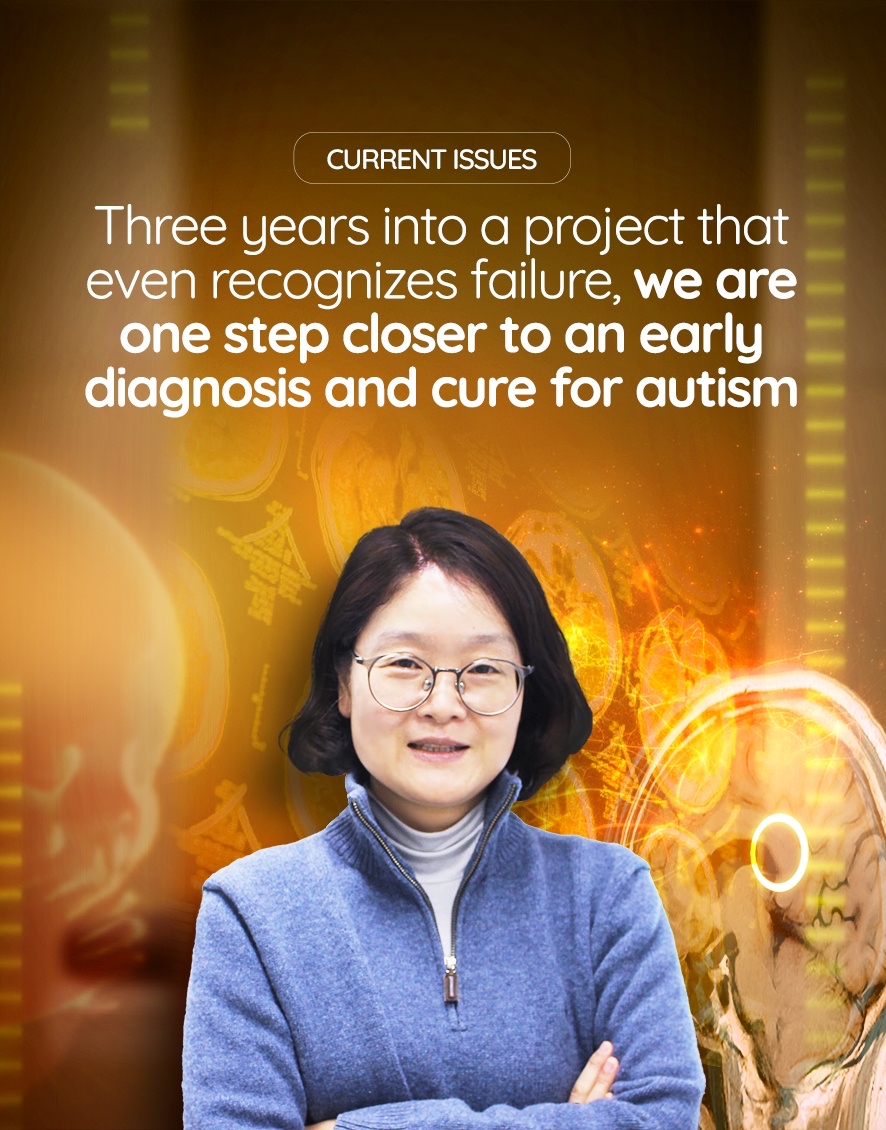
![[GRaND-KIST] From commercialization to future studies...](/app/board/attach/image/12036_1695782150000.do)




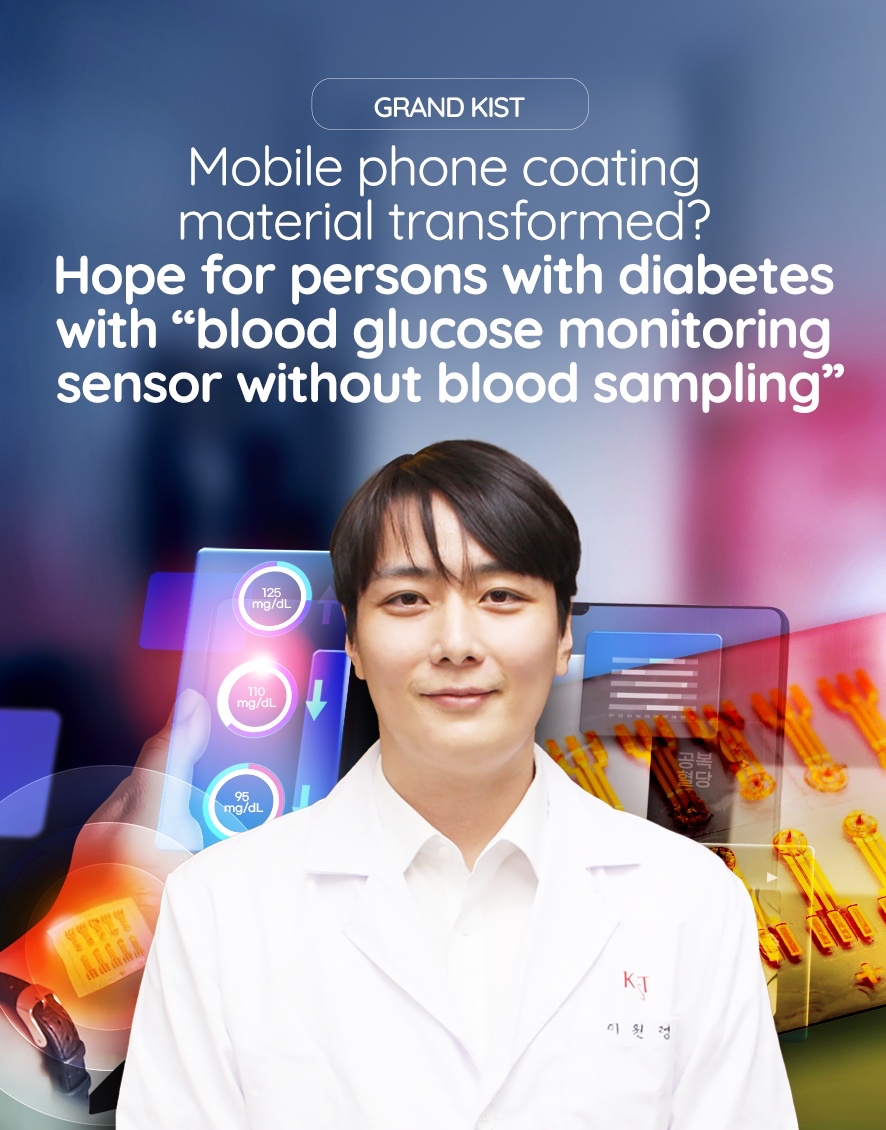
![[Current Issues] Ministry of Science and Technology Protects the Blue Sky](/app/board/attach/image/12039_1695808598000.do)
![[GRaND-KIST] From commercialization to future studies...](/app/board/attach/image/12030_1695693456000.do)

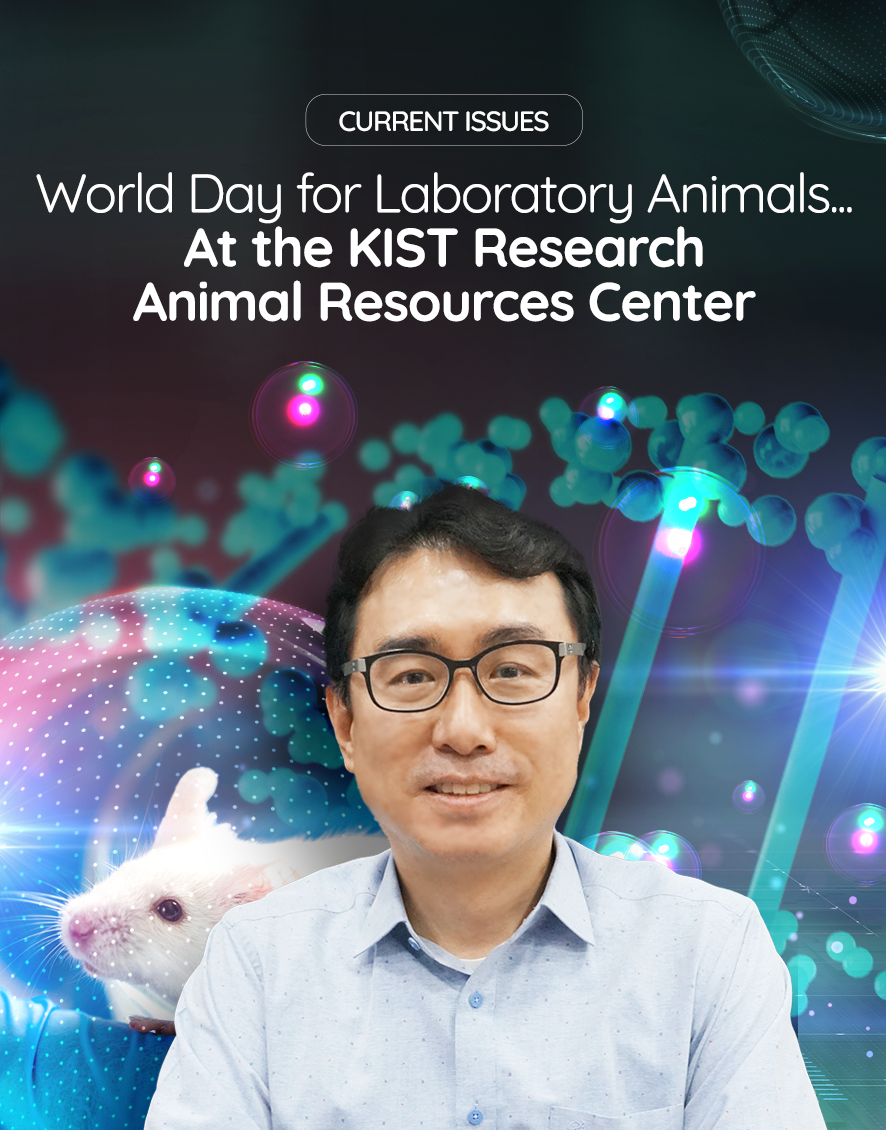
![Was it a quantum computer that fought aganist Thanos? [출처] [Current Issues] Was it a quantum computer that fought aganist Thanos?](/app/board/attach/image/11731_1685523114000.do)


